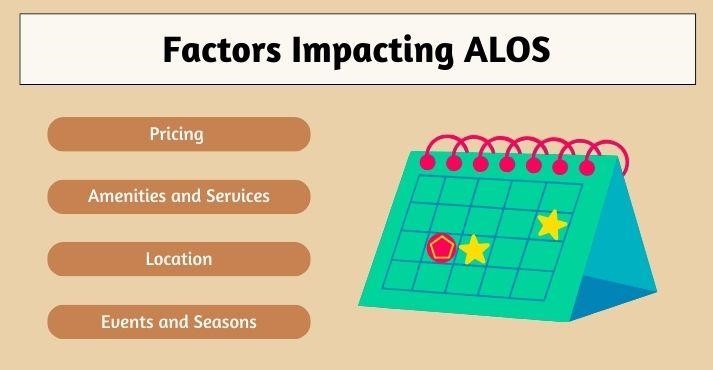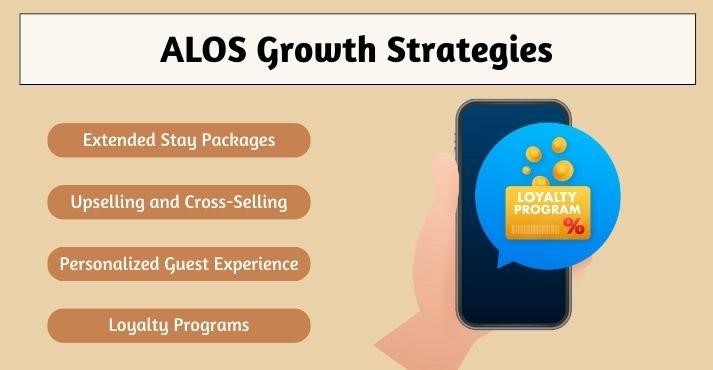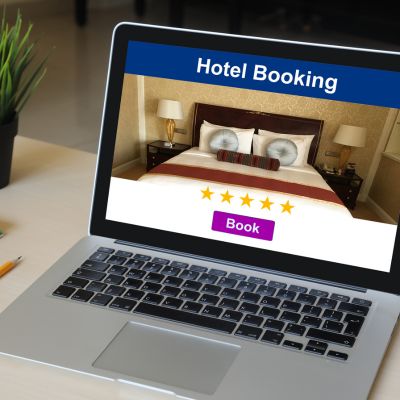Do you know how long your average guest stays at your hotel? Identifying guest stay patterns is essential for improving hotel operations and maximizing revenue.
The Average Length of Stay (ALOS) is a valuable metric that helps hotel managers better understand guest behavior, make more intelligent pricing decisions, and improve operational efficiency.
Knowing your ALOS is key to improving your pricing strategy, forecasting demand, or managing guest experiences. Let’s explore why ALOS matters and how it can transform hotel operations.
What is the Average Length of Stay (ALOS)?
The Average Length of Stay (ALOS) is a simple yet powerful hotel metric. It represents the average number of nights guests stay in a hotel during a given period. This figure is calculated by dividing the total number of room nights by the total number of bookings.
For example, if a hotel has 100 room nights and 50 bookings monthly, its ALOS would be 2. This means that, on average, guests stay for two nights.
Hotels use ALOS to understand how long their guests typically stay and adjust their staffing, inventory management, and revenue forecasting accordingly.
Knowing the ALOS helps hoteliers make more informed decisions, which improves efficiency and guest satisfaction.
Formula:
ALOS = Total Room Nights ÷ Total Reservations
How to Calculate ALOS
Calculating ALOS is straightforward but requires accurate data collection. Here’s a step-by-step process to help you calculate it for your hotel:
- Gather Data: Collect the total number of room nights sold over a specific period (such as a month or year).
- Count Reservations: Determine the total number of individual bookings made during that period.
- Apply the Formula: Use the ALOS formula:
ALOS = Total Room Nights ÷ Total Reservations.
For example, if your hotel had 600 room nights and 300 bookings in one month, the ALOS would be 2. This ALOS calculation helps hoteliers track guest behavior trends and refine their operations to boost guest satisfaction and revenue.
Factors Affecting ALOS

Several factors influence the Average Length of Stay (ALOS) in hotels. When understanding these factors, hotel managers can optimize operations and increase guest retention. Here’s a breakdown of key elements that can affect ALOS:
1. Pricing
Pricing strategies play a significant role in determining how long guests choose to stay. For example, offering competitive rates through dynamic hotel pricing can make a hotel more attractive to budget-conscious travelers.
Hotels can also offer a discount pricing strategy for guests who stay longer, encouraging them to extend their stay.
2. Amenities and Services
The availability and quality of amenities also influence how long guests decide to stay. Hotels with luxurious amenities like spas, pools, and fine dining options tend to have higher ALOS.
For instance, any resort in Bali that offers all-inclusive services may attract vacationers who prefer to stay for a week or longer. The more attractive the services and amenities, the more extended guests remain.
3. Location
Location is a critical factor in determining ALOS. Hotels in prime tourist areas or near business hubs often have longer stay durations.
In Southeast Asia, hotels near major attractions such as Marina Bay Sands in Singapore or Patong Beach in Phuket often see guests staying for extended periods. Travelers visiting iconic landmarks or attending business conferences usually book longer stays, contributing to a higher ALOS.
4. Events and Seasons
Local events and seasons also greatly influence ALOS. Hotels near popular events or festivals, such as the Formula 1 Singapore Grand Prix or Bali’s Galungan Festival, often experience longer stays during these periods.
Additionally, hotels that adjust their pricing and promotions during the shoulder season—the time between peak and off-peak travel seasons—can attract more guests and increase their ALOS.
Why ALOS Matters for Hotels?

The Average Length of Stay (ALOS) is much more than just a simple number on a spreadsheet. It’s a critical metric impacting various areas of hotel operations, from pricing strategies to customer satisfaction and overall profitability.
Comprehending ALOS allows hotel managers to tailor their approach to revenue management, guest retention, and operational efficiency, which are essential for long-term success.
Let’s take a closer look at why tracking ALOS is fundamental for hotels and how it influences different aspects of hotel management.
1. Revenue Management
One of the primary reasons why ALOS is vital for hotels is its direct impact on hotel revenue management. The ALOS hotel metric helps hoteliers understand guest behavior patterns, allowing them to make informed decisions about pricing and promotions.
For instance, a hotel with a short ALOS might focus on attracting more short-term guests by offering attractive weekend packages or last-minute deals.
In contrast, hotels with longer ALOS might prioritize extended stay offers or loyalty programs to encourage guests to stay even longer.
When analyzing ALOS, hotels can create targeted promotional offers that cater to different guest segments. For example, business travelers typically have shorter stays, while families on vacation tend to stay longer.
Also, hotels can effectively lengthen the ALOS by offering extended stay promotions to leisure travelers or discounts for stays beyond a certain number of nights. This fills rooms for more extended periods and improves overall revenue per guest.
2. Customer Retention and Loyalty
Another essential reason to track and optimize ALOS is its strong link to guest retention and loyalty.
When guests stay longer, the hotel has a more significant opportunity to build a meaningful relationship with them.
Longer stays also allow guests more time to experience the hotel’s amenities and services, which can lead to higher satisfaction levels. Satisfied guests are more likely to return, increasing retention and long-term hotel customer loyalty.
Hotels that focus on improving ALOS often implement customer retention strategies to encourage guests to stay longer and return for future visits. One way to do this is by offering personalized experiences tailored to individual guest preferences.
For instance, if a guest enjoys spa treatments, the hotel can offer a special package that includes spa services at a discounted rate for extended stays. This improves the guest experience and encourages them to book a more extended stay.
Another successful strategy is offering hotel customer loyalty programs that reward guests for longer stays or frequent visits. These programs might offer perks such as room upgrades, free breakfasts, or exclusive discounts on future stays.
3. Operational Efficiency
Knowing the Average Length of Stay also plays a crucial role in improving a hotel’s operational efficiency. Hotels with longer ALOS can optimize their operations by reducing the number of room turnovers and housekeeping shifts required.
For instance, a hotel with a high ALOS might not need to schedule daily housekeeping for guests staying more than three nights, allowing them to reduce labor costs and streamline housekeeping operations.
Additionally, longer stays provide hotels with more predictable occupancy patterns, making it easier to plan staffing schedules, manage inventory, and allocate resources more efficiently.
Hotels can adjust their housekeeping, maintenance, and front desk schedules to match their guests’ typical ALOS, reducing unnecessary shifts and improving staff productivity.
Strategies to Increase ALOS

There are several proven strategies that hotels can adopt to increase their Average Length of Stay (ALOS) and boost revenue.
When implementing thoughtful promotions and personalized experiences, hotels can encourage guests to extend their stays, positively impacting revenue and guest satisfaction. Here are some practical strategies for hotels to maximize their ALOS.
1. Extended Stay Packages
One of the simplest and most effective way to increase ALOS is offering extended stay promotions. These packages can offer guests discounted rates for staying longer, such as five or more nights.
Extended stay appeals to various travelers, including business professionals who need accommodations for a work project and families looking for a more extended vacation.
These promotions work particularly well during the shoulder season when hotels aim to fill rooms during periods of lower demand.
Offering incentives for more extended stays can help hotels maintain higher room occupancy rates and attract guests who might otherwise choose a shorter visit. This strategy increases ALOS and stabilizes room revenue during slow periods.
2. Upselling and Cross-Selling
Another powerful approach to increasing ALOS is through upselling and cross-selling. These strategies involve offering guests additional services or experiences that boost their stay and make extending their visit more appealing.
For example, hotels can promote room upgrades, spa treatments, dining experiences, or local tours. When offering these extras, hotels improve the guest experience and encourage guests to stay longer to enjoy everything the hotel offers.
This strategy is particularly effective in Southeast Asia. For instance, hotels in Bali, like the Viceroy, have found success by promoting unique local tours that allow guests to explore the island’s culture, such as cooking classes or guided nature hikes.
Benefits of upselling and cross-selling include:
- Enhanced guest experience: When offered additional services, guests feel like they’re getting more out of their stay, which can motivate them to stay longer.
- Increased revenue per guest: By selling additional services, hotels can boost revenue without increasing room rates while improving ALOS.
3. Personalized Guest Experience
A personalized guest experience is a highly effective strategy for increasing ALOS. When hotels tailor their services to meet their guests’ individual preferences and needs, it leads to higher satisfaction and often results in extended stays.
When creating customized experiences, hotels show guests they are valued, making them more likely to stay longer and return.
The hotel could provide a curated list of nearby coworking spaces or corporate events if a guest is in town for a business trip. For leisure travelers, the hotel could offer custom tours of local attractions or exclusive access to cultural events.
This level of personalization increases ALOS and promotes long-term loyalty, as guests are more likely to return to a hotel that goes above and beyond to meet their needs.
4. Loyalty Programs
Loyalty programs are another excellent tool for increasing ALOS and improving guest retention. These programs reward guests for their loyalty by offering perks such as points that can be redeemed for free nights, room upgrades, or exclusive discounts on future stays.
The longer a guest stays, the more points they can accumulate, creating an incentive for extended stays.
Many Southeast Asian hotels have successfully implemented customer retention strategies centered on loyalty programs. For example, hotels in cities like Kuala Lumpur and Jakarta, like Shangri-La, offer loyalty programs that reward guests with additional benefits for stays over five nights.
These perks include access to exclusive lounges, complimentary meals, or free airport transfers. When incentivizing guests to extend their stays, hotels increase ALOS and cultivate a loyal customer base that is more likely to return in the future.
Conclusion
The Average Length of Stay (ALOS) is a vital metric that directly impacts a hotel’s success in terms of profitability, guest satisfaction, and operational efficiency.
By carefully tracking and optimizing ALOS, hotels can make data-driven decisions that improve overall performance.
Implementing extended stay promotions, upselling additional services, and developing loyalty programs can increase ALOS. These approaches boost revenue and increase guest retention by offering personalized and value-added experiences.
Ultimately, focusing on ALOS allows hotels to better meet their guests’ needs while ensuring longer stays, which benefits both the hotel and its visitors.
When properly managed, ALOS optimization can lead to sustainable growth and a stronger competitive position in the hospitality market.














